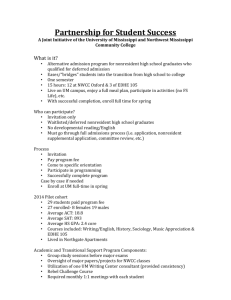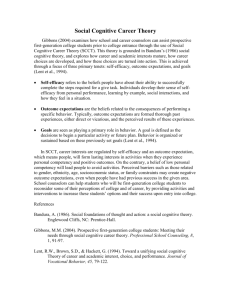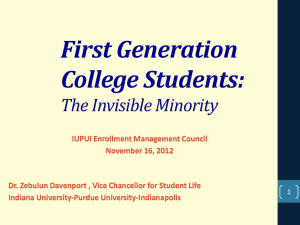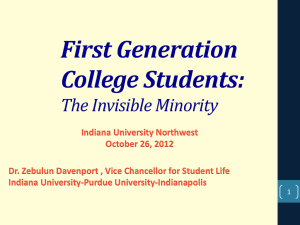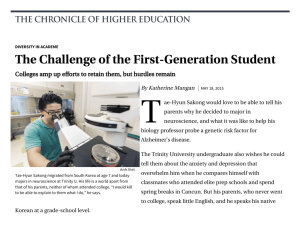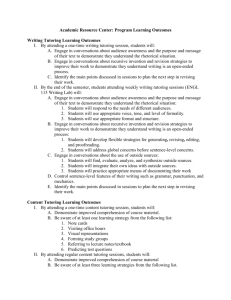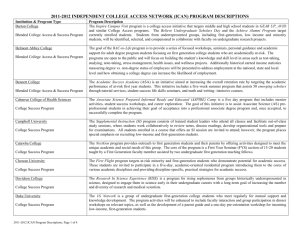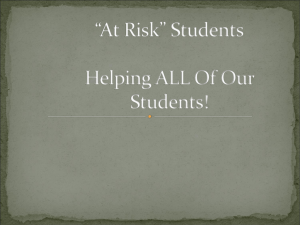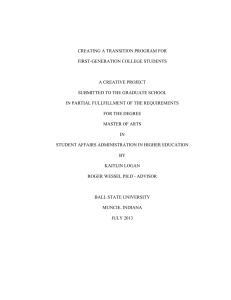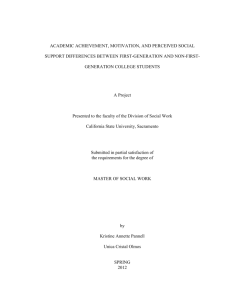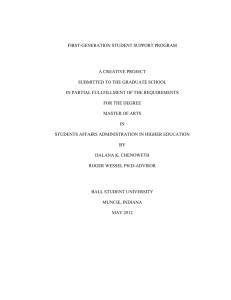First-generation Students
advertisement
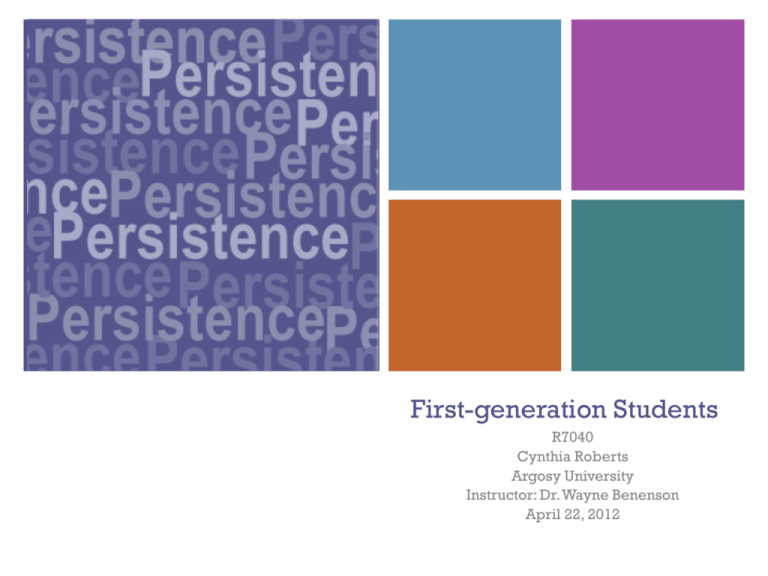
+ First-generation Students R7040 Cynthia Roberts Argosy University Instructor: Dr. Wayne Benenson April 22, 2012 + Dissertation Prospectus Chapter 1: Introduction to the Study Chapter 2: Literature Review Chapter 3: Research Methodology References Appendix + Chapter 1: Introduction More students going to college than ever before From 1999 – 2009, enrollment rose by 38% By 2019, another 32% increase is expected (Fast Facts, n.d.) … but persistence remains a problem Only 57% of first-time students who enrolled in 2002 finished a degree by 2008 (Berkner, Radford & Skomsvold, 2011, p. 11) + Chapter 1: Introduction …furthermore, disparities exist in enrollment & persistence In 2003 – 2004, only 56% of low-income vs. 87% of high-income enrolled in college (“The Condition,” 2011) Low income and first-generation students less likely to enroll in four-year program, competitive colleges, and much less likely complete (Pascarella, et al. 2004; Upcraft, Gardner, & Barefoot, 2004) For example, first-generation students 8.5 times more likely to drop out (Ishitani, 2006) + Chapter 1: Introduction In addition, there is unequal exposure to the arts By education level By socioeconomic status Arts = a form of cultural capital Not changed in over 20 years except for slight variations in type of art. (DiMaggio, P., & Mukhtar, T., 2004) + Chapter 1: Introduction Given that a first generation student is … less likely to finish a college degree And, have limited exposure to art prior to college This study seeks to examine the experiences of first-generation students that choose to study art as their major focus? + Chapter 1: Introduction Research Questions: What motivates a first-generation student to choose an art major and persist to completion? What are the challenges experienced by firstgeneration students as they pursue a degree in art and how do they overcome those challenges? What are the social transformations that occur during the process of choosing an art degree, pursuing the degree and completing the degree? + Chapter 2: Literature Review Research that has been conducted College persistence Themes = academic preparation, demographic studies, transition studies (Pascarella, E., et al.,2004; Tinto, 2003; Upcraft, Gardner, & Barefoot, 2004). The first-generation student Numerous topics: value of mentoring, experiences of rural students, communication fears, motivation, academic preparation, experiences in a commuter school, dormitory experiences, special program studies (Collier, P., & Morgan, D. 2008; Davis, P. L. 2010; Francis, T., & Miller, M., 2008; Ishitani, 2006; Prospero M., Vohra-Gupta S.,2007) + Chapter 2: Literature Review Research that has been conducted …continued Arts Participation Inequality among socioeconomic groups, as cultural capital, & changes over time (20+ years) (DiMaggio, P., & Mukhtar, T., 2004) Research not conducted The persistence of the first-generation student as an art major + Chapter 2: Literature Review What we know about first-generation students Persistence barriers: Social/cultural integration College preparation Employment status Sometimes - lack of parental support (Collier, P., & Morgan, D. 2008; Gatto, 2009; Tinto, 2012; Tinto, 2003; Upcraft, Gardner, & Barefoot, 2004; ) + Chapter 2: Literature Review What we know about first-generation students …continued Persistence likelihood can be increased by: Providing social integration support for FGS students For the most profound effect it should occur within the first three weeks of entering college Helping FGS students overcome fear of communication Helping FGS students acquire intrinsic motivation toward education Providing academic support (Gatto, 2009; Tinto, 2003; Prospero M., Vohra-Gupta S., 2007; Upcraft, Gardner, & Barefoot, 2004; Woosley, S. & Miller, A. ,2009) + Chapter 2: Literature Review What we know about first-generation students …continued Characteristics: More likely to take less classes Less likely to participate in extra curricular activities Benefit the most from extra curricular activities Less likely to aspire to higher level of education Less likely to apply to more restrictive college Afraid to communicate with peers & instructors (Francis, T., & Miller, M., 2008; Pascarella, E., et. al., 2004) + Chapter 2: Literature Review Theoretical foundations Social theories provide important foundations that help researchers understand educational research (Adams, J., Cochrane, M., & Dunne, L., 2011) Theories of cultural and social capital by Pierre Bourdieu Arts Participation studies of Paul DiMaggio Vincent Tinto’s model of institutional departure The discovery and understanding of theories ongoing process occurring before, during and after the collection of data + Chapter 3: Research Methodology Qualitative - phenomenological inquiry Why phenomenological inquiry? personal stories = greater depth to the understanding of the phenomena (Hightower, 2007) Phenomenological inquiry focuses on describing the common lived experiences of individuals that share a phenomenon Not much is known about the experiences of FGS art majors (Creswell, 2007) + Chapter 3: Research Methodology Research Design Sampling Sample size – dependent on objective/finding repetitive data. Bernard and Ryan (2010), recommend six to ten knowledgeable informants for phenomenological study + Chapter 3: Research Methodology Research Design Sampling: Definition of the study population The art student Design career oriented majors, fine art majors, performance art majors such as drama, dance, or music, art history majors Similar phenomenological experiences expected (Hoekel, R.,Maros, A., Moran, E., personal communications, 2012) The first-generation student No parent has attended college …or step parent that lives with the child/has influence in the child’s life … absent parent excluded Recent graduate Consider generational factors + Chapter 3: Research Methodology Research Design Sampling Purposive sampling – as modeled from study by Frances (2009) Requests for participants from various alumni groups from colleges within 200 mile radius until a pool of willing participants is obtained May also utilize gatekeepers or snowball referrals to saturate pool of participants (Bernard and Ryan, 2010; Hennick and Bailey, 2011) Select a range of participants from that pool to ensure an even participation based on a full spectrum of diverse students + Chapter 3: Research Methodology Research Design Data collection Audio recorded personal interviews (with back up recorder) transcribed Field notes – immediately after interviews to capture full experience Reflexive researcher journal entries (Agosthinho, 2004; BradburyJones, C. 2007) Ethical considerations Ensure confidentiality Letter of consent Member checking for accuracy + Chapter 3: Research Methodology Research Design Interview topics: (for specific questions – see appendix) Exploration of FGS first exposure to art Exploration of FGS student experience Exploration of social experiences during college Interview questions will be piloted to ensure they will adequately probe for the necessary information + Chapter 3: Research Methodology Data analysis Transcribe interviews / use software for coding Inductive data analysis – build patterns, categories and themes from the bottom up, organizing into increasingly more abstract units Hew and Wing (2003) suggest using an inter-coder reliability method consisting of two coders coding the material and then cross-examining the results. + Chapter 3: Research Methodology To establish trustworthiness Prolonged engagement Persistent observation Triangulation Peer debriefing Member checks Thick descriptions Audit trail access Reflexive journaling (Agastinho, 2004: Bradbury-Jones, 2007) + Chapter 3: Research Methodology Ethical considerations Full disclosure of researcher’s potential bias (First-generation student) Informed consent – all participants must be willing/may withdraw at any time No Deception – will identify and communicate with participants how research will be used Confidentiality – will identify how privacy of information will be protected including confidentiality of “focus group” participation by all members of the group Benefits of research to participants must outweigh risks – identify small payment made to participants (Creswell, 2007) + Resources Adams, J., Cochrane, M., & Dunne, L. (2011). Applying theory to educational research; An introductory approach with case studies. West Sussex, UK: Wiley-Blackwell. Agostinho S. (2004). Naturalistic inquiry in e-learning research. International Journal of Qualitative Methods, (4)1. Berkner, L.; Radford, A.; & Skomsvold, P. (July, 2011). Web tables—six-year attainment, persistence, transfer, retention, and withdrawal rates of students who began postsecondary education in 2003-04. Retrieved from http://nces.ed.gov/pubs2011/2011152.pdf Bernard, H., Ryan, G. (2010). Sampling. Analyzing qualitative data: Systematic approaches. (pp.357-374). Thousand Oaks, California: Sage. Bradbury-Jones, C. (2007). Enhancing rigour in qualitative health research: exploring subjectivity through Peshkin's I's. Journal of Advanced Nursing, 59(3), 290-298. Collier, P., & Morgan, D. (2008). “Is that paper really due today?”: differences in firstgeneration and traditional college students’ understandings of faculty expectations. Higher Education, 55(4), 425-446. Creswell, John. (2007). Qualitative Inquiry and Research Design: Choosing Among Five Approaches, 2nd Edition. Sage Publications. Davis, P. L. (2010). Navigating uncharted waters – the effect of mentoring on the success and retention of first-generation college students at two Texas community colleges: A case study. (Doctorial dissertation). Available from ProQuest Dissertations and Theses database. (UMI No. 3423813) + Resources …continued DiMaggio, P., & Mukhtar, T. (2004). Arts participation as cultural capital in the United States, 1982-2002: Signs of decline? Poetics 32(2), 169-194. Fast facts. (n.d.). IES National Center for Education Statistics. Retrieved from http://nces.ed.gov/fastfacts/display.asp?id=51 Frances, S. (2009). Older adults and life-long learning: women over 50 engaged in postbaccalaureate study – a phenomenological inquiry. (Doctorial dissertation). Francis, T., & Miller, M. (2008). Communication apprehension: levels of first-generation college students at 2-year institutions. Community College Journal of Research and Practice, 32, 38-55. doi: 10.1080/10668920701746688 Gatto, L. (2009). An exploratory, phenomenological study of the lived experience of firstgeneration female students. (Master’s Thesis, University of Guelph (Canada). Retrieved from https://atrium.lib.uoguelph.ca/xmlui/handle/10214/2048 Hennink, M., Hutter, I., Bailey, A. (2011). Ethical issues in qualitative research. Qualitative research methods. (pp. 61-77). London: Sage Hew K., & Wing, S. (2003). Models to evaluate online learning communities of asynchronous discussion forums. Australian Journal of Educational Technology, 19(2), 241-259. Retrieved from http://www.ascilite.org.au/ajet/ajet19/hew.html Hightower, D. R. (2007). Toward creating anomalies: Examining institutional factors that cultivate educational resilience among low-income, first-generation students. (Doctoral dissertation). Available from ProQuest Dissertations and Theses database. (UMI No. 3272454) + Resources Ishitani, T. T. (2006). Studying attrition and degree completion behavior among firstgeneration college students in the United States. Journal of Higher Education, 77(5), 861885. Lowery-Hart, R., & Pacheco, G. (2011). Understanding the first-generation student experience in higher education through a relational dialectic perspective. New Directions for Teaching & Learning, 2011(127), 55-68. Pascarella, E., Pierson, C., Wolniak, G. & Terenzini, P. (2004). First-generation college students: additional evidence on college experiences and outcomes. The Journal of Higher Education. 75 (3). Prospero M., Vohra-Gupta S. (2007). First Generation college students: Motivation, integration, and academic achievement. Community College Journal of Research and Practice. Doi: 10.1080/10668920600902051. Tinto, V. (2003). Learning better together: the impact of learning communities on student success. Retrieved from http://faculty.soe.syr.edu/vtinto/ The condition of education: Postsecondary expectations of 12th graders. (2011). Retrieved from http://nces.ed.gov/programs/coe/indicator_ect.asp Upcraft, M.L., Gardner, J.N., & Barefoot, B.O. (2004). Challenging and supporting the firstyear student: A handbook for improving the first year of college. San Francisco: JosseyBass. Woosley, S. A. & Miller, A. L. (2009). Integration and institutional commitment as predictors of college student transition: are third week indicators significant? College Student Journal, 43(4), 1260-1271. + Appendix Research questions: Topic: Exploration of FGS exposure to art/design world Describe to me how you came to the decision to pursue an art/design major. (probe: key individuals, activities, challenges) Topic: Exploration of FGS student experience Before you started your degree, what did you think it would be like to be an art student? (probe: how they got information, who they got information from) How did the experience of being an art/design student differ from your expectations? (probe: difference between actual and expectations, how did they adapt to the differences) Topic: Exploration of social support in college Tell me about the friends you had during college. (probe: influence of friends, support of friends, cultural capital, friendship challenges, differences between college and precollege friendships) Tell me about your family? (probe for influence, support, lack of support, challenges.) You were asked to bring an item to the interview that reminds you of your time in college. Can you tell me about the item you brought and what it means to you.
